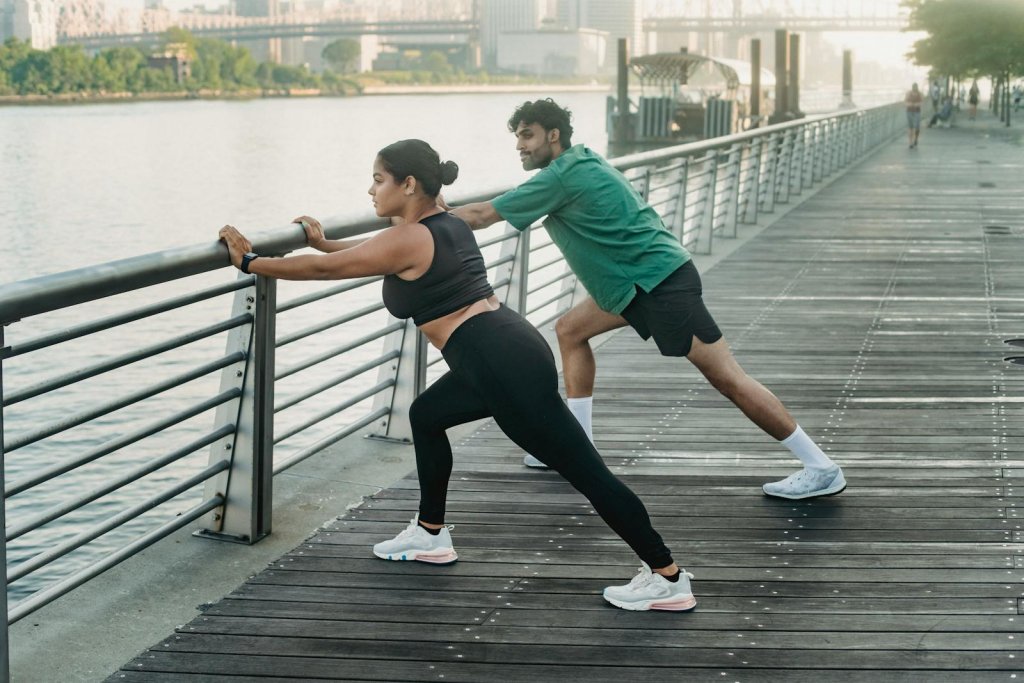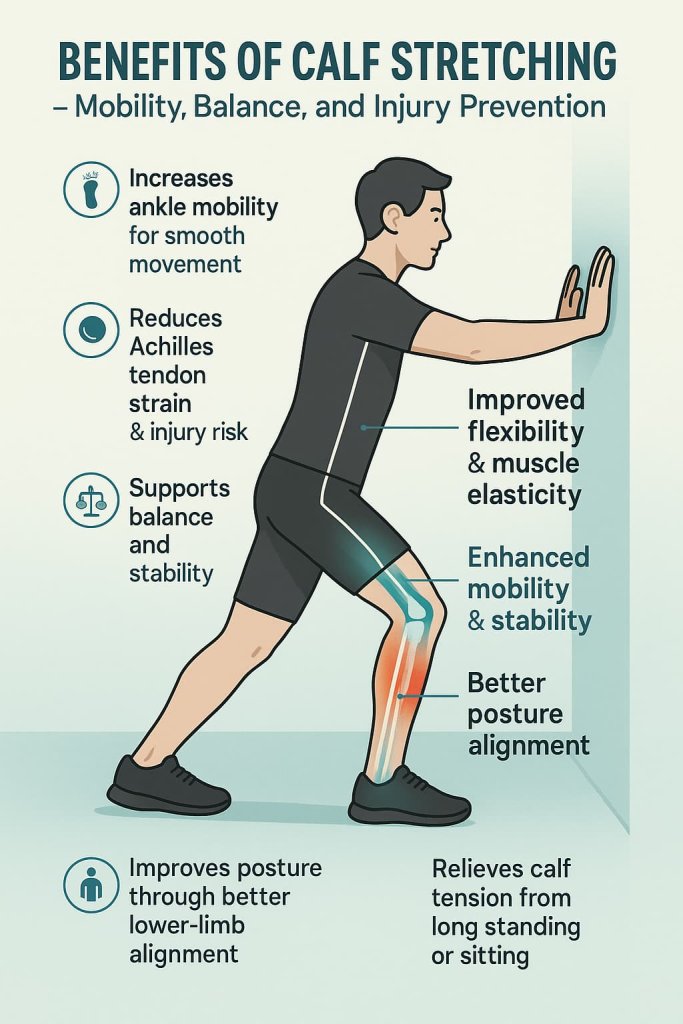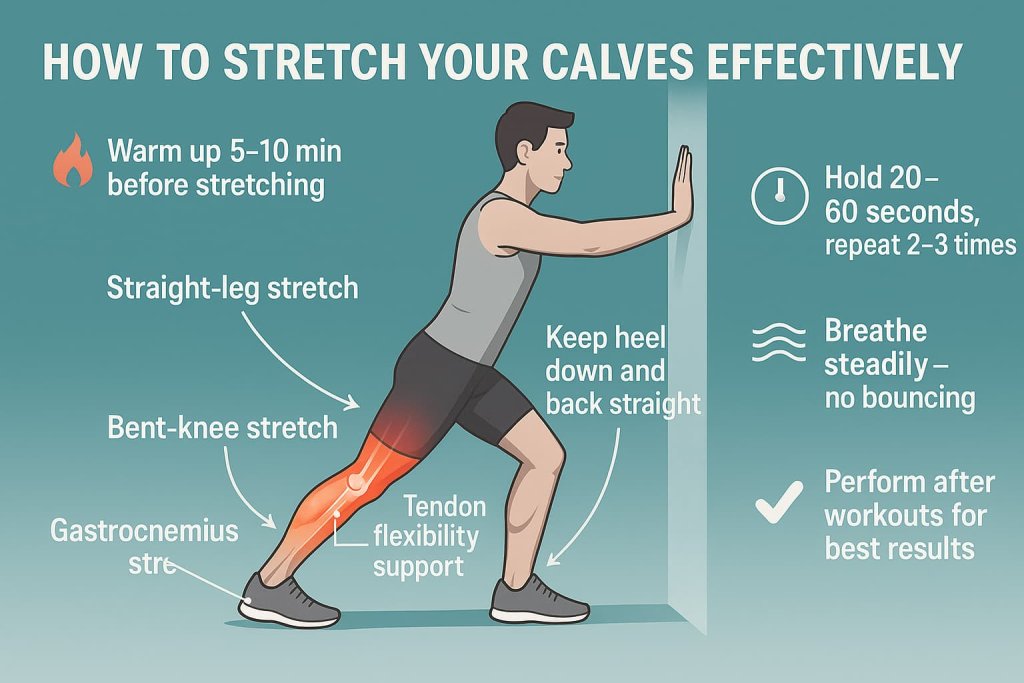Calf stretching exercises help improve flexibility, ankle mobility, and reduce the risk of injuries such as Achilles tendinitis and plantar fasciitis. Tight calves restrict movement, alter gait mechanics, and contribute to ankle and knee strain — especially for runners, lifters, and people who stand for long periods.

Understanding how to stretch your calves properly is key for maintaining full range of motion, improving circulation, and promoting long-term lower-body health. This guide covers 10 of the best calf stretching exercises, based on the latest research and physiotherapy recommendations, to keep your legs strong, mobile, and pain-free.
Benefits of Calf Stretching

- Increases ankle mobility for smoother walking, squatting, and running mechanics.
- Reduces risk of Achilles tendon injuries by improving muscle elasticity.
- Supports balance and stability during lower-body movements.
- Eases calf tension from long sitting or standing hours.
- Improves posture by enhancing alignment through the ankle and knee.
Research Insight:
A 2024 review in Sports Medicine – Open found that consistent calf stretching (≥15 minutes per session, for at least 6 weeks) improved flexibility and muscle function in both athletes and sedentary adults.
Anatomy of the Calf Muscles

Your calves are made up of two main muscles:
- Gastrocnemius: The larger, visible muscle forming the calf bulge. It crosses both the knee and ankle joints and is active during standing, jumping, and running.
- Soleus: A deeper, flatter muscle that lies beneath the gastrocnemius. It stabilizes the ankle and plays a crucial role in posture and endurance activities.
Both attach to the Achilles tendon, connecting to your heel bone. When these muscles tighten, it limits ankle dorsiflexion and can lead to compensations in the knees and hips.
How to Stretch Your Calves Effectively
To get the most out of your calf stretches, focus on warm-up, form, and consistency. The goal is to lengthen both the gastrocnemius and soleus muscles safely while improving ankle mobility.

- Warm up first: Walk or do light calf raises for 5–10 minutes.
- Use proper form: Keep your heel down, knee aligned, and back straight. Stretch to mild tension — not pain.
- Hold and repeat: Maintain each stretch for 20–60 seconds, repeat 2–3 times.
- Target both muscles: Straight leg for gastrocnemius, bent leg for soleus.
- Breathe steadily: Avoid holding your breath; relax into the stretch.
- Be consistent: Stretch 3–5 times per week for lasting flexibility.
Trainer Tip: Always stretch after workouts or when muscles are warm for the safest and most effective results.
10 Best Calf Stretching Exercises
These 10 calf stretching exercises target both the gastrocnemius and soleus muscles to improve flexibility, ankle mobility, and posture alignment.
Incorporate them regularly to relieve tightness, enhance performance, and prevent lower-leg injuries.
1. Standing Wall Calf Stretch
Why it works:
This classic stretch effectively targets the gastrocnemius, the larger calf muscle responsible for explosive movements like running, sprinting, and jumping. It helps relieve tightness from long periods of standing or wearing heeled shoes and improves ankle flexibility.
Muscles worked:
Gastrocnemius (primary), soleus (secondary), Achilles tendon.
How to do it:
- Stand facing a wall with your hands at shoulder height.
- Step one foot back, keeping the heel flat and the back leg straight.
- Lean forward slowly until you feel a stretch in the upper calf.
- Hold for 20–30 seconds, repeat 2–3 times per side.
Trainer Tip:
Keep your toes pointing straight ahead and your heel grounded to maximize the stretch.
2. Bent-Knee Wall Stretch
Why it works:
This variation shifts focus to the soleus, the deeper muscle beneath the gastrocnemius, which is key for ankle stability and endurance activities like walking or cycling.
Muscles worked:
Soleus (primary), Achilles tendon, tibialis posterior (stabilizer).
How to do it:
- Stand in the same position as the standing wall stretch.
- Bend your back knee slightly while keeping the heel pressed to the ground.
- Lean forward gently until you feel a stretch lower in the calf.
- Hold for 30 seconds; repeat 2 times per leg.
Trainer Tip:
Keep your torso upright and move slowly to feel the deep stretch without heel lift.
3. Downward Dog Calf Stretch (Yoga Pose)
Why it works:
This yoga-based stretch lengthens both calf muscles simultaneously while improving flexibility in the hamstrings and hips — perfect for full posterior chain mobility.
Muscles worked:
Gastrocnemius, soleus, hamstrings, plantar fascia.
How to do it:
- Begin in a plank position with hands under shoulders.
- Lift your hips toward the ceiling into an inverted “V.”
- Press both heels toward the ground while keeping legs straight.
- Pedal your feet alternately to deepen the stretch.
Trainer Tip:
Keep your back flat and avoid rounding your shoulders — focus on smooth breathing throughout.
4. Seated Towel Stretch
Why it works:
A gentle, low-impact stretch ideal for beginners, office workers, or those recovering from calf or Achilles injuries.
Muscles worked:
Gastrocnemius, soleus, Achilles tendon.
How to do it:
- Sit on the floor with your legs extended in front.
- Loop a towel or resistance band around the ball of one foot.
- Gently pull the towel toward you until you feel tension in your calf.
- Hold for 30 seconds, repeat 2–3 times per side.
Trainer Tip:
Keep the leg straight for upper-calf emphasis or bend slightly to target the soleus.
5. Stair Calf Stretch
Why it works:
This exercise uses body weight and gravity to lengthen the entire calf complex, improving flexibility for running, walking, and jumping.
Muscles worked:
Gastrocnemius, soleus, Achilles tendon, tibialis anterior (eccentric stabilizer).
How to do it:
- Stand on a stair or step with your heels hanging off the edge.
- Slowly drop your heels below stair level until you feel a stretch.
- Hold for 20–30 seconds, then rise back up with control.
- Perform 2–3 rounds.
Trainer Tip:
Use a railing for balance and perform one leg at a time to focus on alignment.
6. Foam Roller Calf Release
Why it works:
This self-myofascial release technique improves blood flow, breaks up muscle adhesions, and reduces stiffness in the calves.
Muscles worked:
Gastrocnemius, soleus, peroneals, deep fascia.
How to do it:
- Sit on the floor with legs extended and a foam roller under your calves.
- Support your body with your hands and lift your hips slightly.
- Roll slowly from ankles to knees for 60 seconds per leg.
- Pause on tight or tender areas for 10–15 seconds.
Trainer Tip:
Cross one leg over the other for extra pressure or use small back-and-forth motions for deeper release.
7. Incline Board Calf Stretch
Why it works:
Clinically proven to reduce calf tightness and lower back pain, this exercise promotes optimal dorsiflexion, essential for squats and running mechanics.
Muscles worked:
Gastrocnemius, soleus, Achilles tendon.
How to do it:
- Stand on an incline board with toes elevated and heels down.
- Keep knees straight and hold for 30–60 seconds.
- Gradually increase duration as flexibility improves.
Trainer Tip:
Maintain a tall posture; use this stretch before squats or lunges to enhance ankle range of motion.
8. Dynamic Calf Stretch (Heel Raises & Lowering)
Why it works:
Combines stretching with strengthening, improving both flexibility and functional stability of the lower leg.
Muscles worked:
Gastrocnemius, soleus, peroneals, tibialis posterior.
How to do it:
- Stand tall with feet hip-width apart, near a wall or sturdy support.
- Rise onto your toes, pause, then slowly lower your heels below floor or step level.
- Perform 10–15 repetitions, 2–3 sets.
Trainer Tip:
Control both directions — slow lowering increases eccentric strength and mobility.
9. Lunge Calf Stretch
Why it works:
Adds a functional component to calf stretching, improving coordination between the hips, knees, and ankles.
Muscles worked:
Gastrocnemius, soleus, hip flexors, gluteus maximus.
How to do it:
- Step one leg forward into a lunge.
- Keep your back heel flat and gently press the back knee downward.
- Feel the stretch through your back calf and front hip.
- Hold for 30 seconds, switch sides.
Trainer Tip:
Keep your torso upright and both hips squared forward to prevent twisting.
10. Wall Soleus Stretch (Knee-to-Wall)
Why it works:
Improves ankle dorsiflexion — critical for deep squats, sprinting, and balance control.
Muscles worked:
Soleus, Achilles tendon, tibialis posterior.
How to do it:
- Stand facing a wall with one foot about 2–3 inches away.
- Bend your front knee slowly toward the wall while keeping your heel down.
- Stop when your heel begins to lift.
- Hold for 20–30 seconds, repeat 3 times per side.
Trainer Tip:
Progress over time by moving your foot slightly farther from the wall each week to build controlled flexibility.
When to Stretch Your Calves
- After workouts: Ideal time for static holds (20–60 seconds).
- Before training: Use dynamic variations (heel drops or walking lunges).
- During recovery days: Helps maintain flexibility and blood flow.
Safety & Precautions
- Always warm up before stretching (e.g., brisk walking, leg swings).
- Avoid bouncing or forcing the stretch.
- Stop immediately if you feel sharp or radiating pain.
- If you have Achilles tendinopathy, consult a physiotherapist before beginning.
- Stretch gently after exercise when muscles are warm.
Following these precautions keeps your training effective, safe, and medically appropriate — a key requirement for YMYL compliance.
FAQs
1. How often should I stretch my calves?
At least 3–5 times per week, or daily if you experience tightness.
2. When is the best time to stretch — before or after exercise?
Dynamic stretches before; static stretches after workouts.
3. How long should I hold a calf stretch?
Hold each stretch for 20–60 seconds and repeat 2–3 times.
4. Can calf stretching help with plantar fasciitis?
Yes — it can relieve tension on the Achilles and plantar fascia, reducing strain.
5. Are calf stretches safe for seniors?
Yes, when performed gently and with balance support (e.g., wall or chair).
6. Can I stretch too much?
Overstretching can cause microtears or soreness; stop if pain occurs.
7. Should I stretch if I have an injury?
Consult a healthcare provider first, especially for Achilles or calf tears.
Conclusion
Regular calf stretching is one of the simplest ways to keep your lower legs flexible, aligned, and injury-free. Whether you’re an athlete, office worker, or senior, improving calf mobility enhances posture, performance, and comfort in everyday life.
Start today — just a few minutes daily can make every step smoother.
References
- Warneke et al., 2024 — Sports Medicine–Open (Systematic Review & Meta-analysis)
Chronic static stretching, when done with sufficient volume and duration, can yield small but meaningful gains in strength/size.
Effects of Chronic Static Stretching on Maximal Strength and Muscle Hypertrophy. - Radford et al., 2006 — Systematic Review (Open Access, BJSM/CRD)
Calf stretching provides a small but statistically significant increase in ankle dorsiflexion (clinical impact depends on context).
Does Stretching Increase Ankle Dorsiflexion Range of Motion?. - Wiewelhove et al., 2019 — Frontiers in Physiology (Meta-analysis, Open Access)
Foam rolling can acutely increase ROM and aid recovery without harming performance—useful alongside stretching.
A Meta-Analysis of the Effects of Foam Rolling on Performance and Recovery. - Behm & Chaouachi, 2011 — European Journal of Applied Physiology (Review)
For warm-ups, prefer dynamic over long static holds; save longer static stretching for cool-downs or separate sessions.
A Review of the Acute Effects of Static and Dynamic Stretching on Performance. - Esteban-García et al., 2024 — Applied Sciences (Systematic Review & Meta-analysis)
Dynamic stretching in warm-ups improves lower-limb performance and ROM; both static and dynamic help ROM overall.
Does Static or Dynamic Stretching in the Warm-Up Improve Jump Height and ROM?. - Chimenti et al., 2024 — JOSPT Clinical Practice Guideline (Midportion Achilles Tendinopathy)
Clinicians may use plantar-flexor stretching (knee flexed/extended) as part of care; tendon-loading exercise remains first-line.
Achilles Pain, Stiffness, and Muscle Power Deficits — 2024 CPG. - Takeuchi et al., 2023 — Meta-analysis (PubMed)
3–12 weeks of static stretch training can moderately decrease muscle stiffness versus control.
Long-Term Static Stretching Can Decrease Muscle Stiffness.
